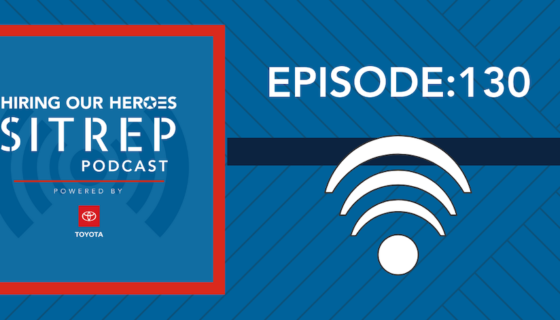‘Our Success Is Built on a One-on-One Personal Touch’ – A Conversation about WWP’s Warriors to Work Program

The Wounded Warrior Project’s Warriors to Work program, offers free career counseling to help wounded service members and their families find their next careers after serving in the Armed Forces.
Since its inception in 2009, the Warriors to Work program has placed more than 15,000 wounded veterans and family support members in meaningful employment.
Listen in as Bryan Rollins, national director for the Warriors to Work program, discusses how this program is reducing the wounded warrior unemployment rate and offers suggestions for ways that employers can connect with wounded warriors at hiring fairs and in their workplaces.
Top Takeaways from “Our Success Is Built on a One-on-One Personal Touch”:
1. According to a 2019 Wounded Warrior Project survey, the wounded warrior unemployment rate is 12%, down from 20% in 2014.
“A 12% unemployment rate is pretty high and that’s the category of folks that we’re looking to help.” – Bryan Rollins, national director for the Warriors to Work program at the Wounded Warrior Project
2. The Warriors to Work program includes professional skills training, resume assistance, and networking opportunities that put veterans and family members in the same room with employers looking to hire them.
“Warriors to Work helps them find their next careers as they transition from the military into civilian life. It empowers them to translate their military experience on a civilian resume.” – Bryan Rollins, national director for the Warriors to Work program at the Wounded Warrior Project
Related: Securing Flexible Employment Is a Battle Our Military Caregivers Face
3. The team of 28 career specialists at WWP met repeatedly with 5,000 warriors for a total of 42,000 engagements in one year. Engagements include one-on-one counseling, interview training, job leads, and discussions about goal setting.
“Our success is built on that one-on-one personal touch. We provide high touch, which leads to high impact. We’re not just providing a job lead — I think that’s our secret sauce.” – Bryan Rollins, national director for the Warriors to Work program at the Wounded Warrior Project

4. The Wounded Warrior Project partners with 350 employers by connecting them with qualified candidates, providing information and education about combat-related injuries, and facilitating a productive onboarding process.
“We provide employers with information that lets them know what a transitioning military member may need as they step into their first civilian employment. We do this to try to develop a long-lasting relationship so that a successful hire turns into 10 more successful hires.” – Bryan Rollins, national director for the Warriors to Work program at the Wounded Warrior Project
5. Veterans are an asset in our workforce.
“We want employers to recognize that veterans offer a lot. You’ll find that they were hired into a job that they are overqualified for and that they bring in a lot of skills that would help your organization to grow even more.” – Bryan Rollins, national director for the Warriors to Work program at the Wounded Warrior Project



